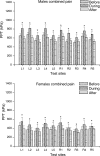Experimental muscle pain impairs descending inhibition
- PMID: 18977598
- PMCID: PMC2732020
- DOI: 10.1016/j.pain.2008.09.027
Experimental muscle pain impairs descending inhibition
Abstract
In chronic musculoskeletal pain conditions, the balance between supraspinal facilitation and inhibition of pain shifts towards an overall decrease in inhibition. Application of a tonic painful stimulus results in activation of diffuse noxious inhibitory controls (DNIC). The aims of the present experimental human study were (1) to compare DNIC, evoked separately, by hypertonic saline (6%)-induced muscle pain (tibialis anterior) or cold pressor pain; (2) to investigate DNIC evoked by concomitant experimental muscle pain and cold pressor pain, and (3) to analyze for gender differences. Ten males and 10 age matched females participated in two sessions. In the first session unilateral muscle pain or unilateral cold pressor pain were induced separately; in the second session unilateral muscle pain and unilateral cold pressor pain were induced concomitantly. Pressure pain thresholds (PPT) were measured around the knee joint before, during, and after DNIC induction. Cold pressor pain increased PPT in both males and females with greater increases in males. Hypertonic saline-evoked muscle pain significantly increased PPT in males but not in females. When cold pressor and muscle pain were applied concomitantly the PPT increases were smaller when compared to the individual sessions. This study showed for the first time that two concurrent conditioning tonic pain stimuli (muscle pain and cold pressor pain) cause less DNIC compared with either of the conditioning stimuli given alone; and males showed greater DNIC than females. This may explain why patients with chronic musculoskeletal pain have impaired DNIC.
Figures





References
-
- Antal M, Petko M, Polgar E, Heizmann CW, Storm-Mathisen J. Direct evidence of an extensive GABAergic innervation of the spinal dorsal horn by fibres descending from the rostral ventromedial medulla. Neuroscience. 1996;73:509–18. - PubMed
-
- Arendt-Nielsen L, Gotliebsen K. Segmental inhibition of laser-evoked brain potentials by ipsi- and contralaterally applied cold pressor pain. Eur J Appl Physiol Occup Physiol. 1992;64:56–61. - PubMed
-
- Baad-Hansen L, Poulsen HF, Jensen HM, Svensson P. Lack of sex differences in modulation of experimental intraoral pain by diffuse noxious inhibitory controls (DNIC). Pain. 2005;116:359–65. - PubMed
-
- Bouhassira D, Danziger N, Atta N, Guirimand F. Comparison of the pain suppressive effects of clinical and experimental painful conditioning stimuli. Brain. 2003;126:1068–78. - PubMed
-
- Bragdon EE, Light KC, Costello NL, Sigurdsson A, Bunting S, Bhalang K, et al. Group differences in pain modulation: pain-free women compared to pain-free men and to women with TMD. Pain. 2002;96:227–37. - PubMed
MeSH terms
Substances
Grants and funding
LinkOut - more resources
Full Text Sources
Medical

